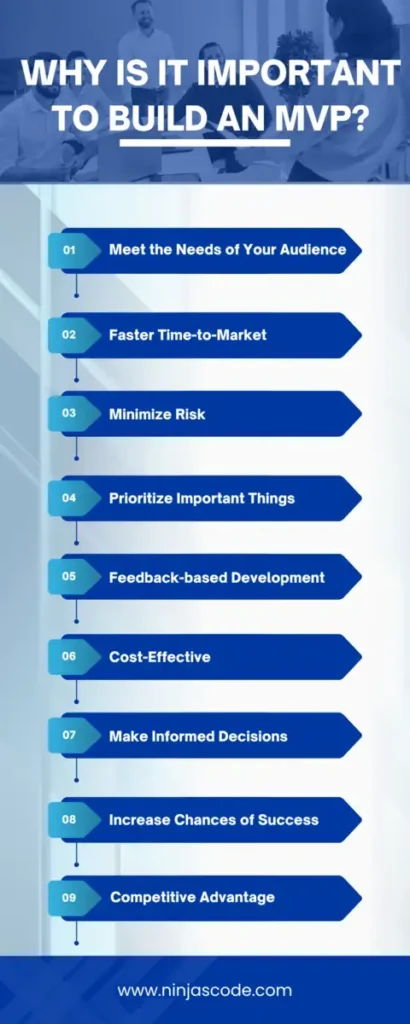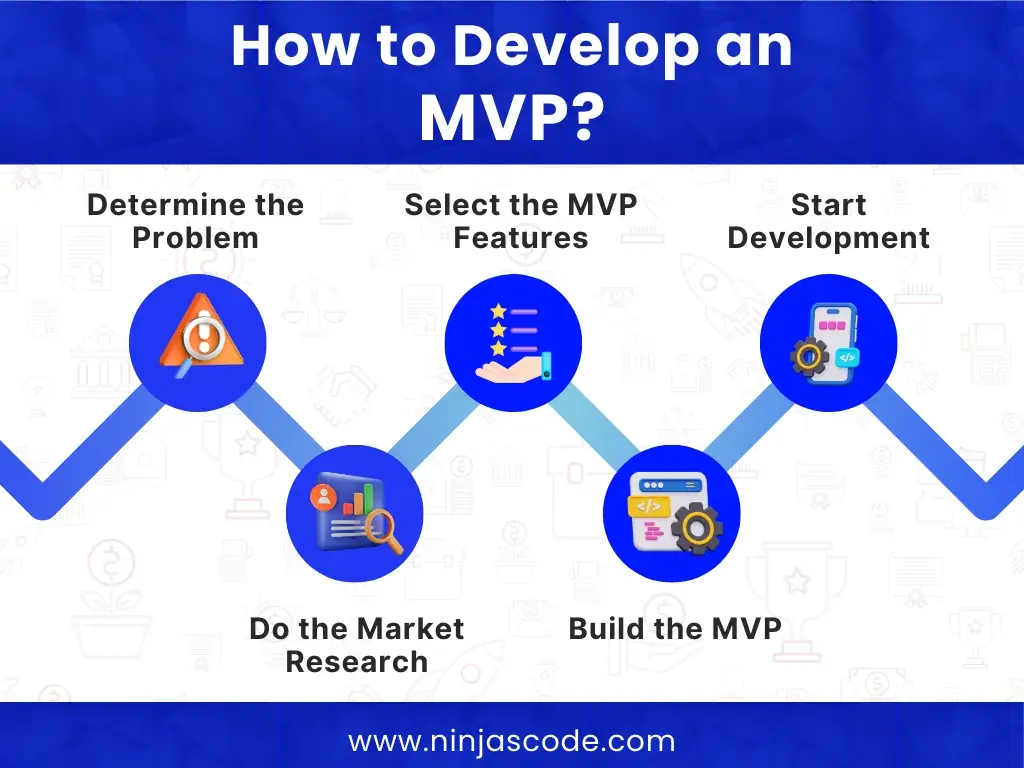
Nowadays, software development poses numerous challenges for companies aiming to create products that meet customer needs and stand out from the competition. In this context, the adoption of the MVP (Minimum Viable Product) approach has proven to be a successful strategy, offering companies an opportunity to develop their products efficiently and effectively.
MVP is a common strategic approach and has gained significant popularity in recent years. It allows businesses to mitigate the risks associated with investing extensive time and resources into product development.
If you’re looking to reduce the risk of failure during the early stages of starting a business and enhance your chances of investments, developing a minimum viable product should be your priority.
In this blog, we’re exploring the MVP in detail so you have a better understanding of it before developing it.
What is MVP Development?
MVP development is the product development approach that focuses on building the product with minimum effort and resources. It is a simplified version of the product that contains only the essential feature set.
The main purpose of MVP development is to:
- Release a product to the market as quickly as possible.
- Save money and time on a big roll-out to the market if the idea doesn’t work.
- Reduce time-to-market for new feature releases.
- Help you validate a product idea with minimal features.
Moreover, MVP is a powerful tool at the beginning of a product development process. To determine whether your idea is worth pursuing further and what path is safe to take in your search for product-market fit, you should first create a minimal viable product.
Characteristics of a Successful MVP Development
For the success of an MVP, below are a few characteristics that should be taken into consideration:
Sustainability and Adaptability: The MVP has the potential to accommodate future features and enhancements. It enables founders to build the product according to changing market demands and user feedback.
Usability: The MVP should be usable to early customers. It attracts users to engage with the product and provide valuable feedback.
Reduce Cost: By investing in the essential features of your product, you can reduce development costs and save money.
Data-driven Approach: A successful MVP depends on gathering meaningful data and user insights. It helps you to gather valuable information to make better decisions.
Launch Your SaaS Product with NinjasCode
Why Is It Important to Build an MVP?
MVP in software development has grown in popularity as organizations, from startups to enterprises. So, let’s explore why a company considers building an MVP that gives them several valuable benefits.

Meet the Needs of Your Audience
MVP development allows you to gather valuable user feedback. When creating a new software product, an MVP is a useful tool for getting input from potential customers. Early users of the product have the opportunity to test it out and give feedback to the team. Based on the feedback, the team can make adjustments or enhancements that will be helpful when the product is formally released.
Faster Time-to-Market
Launching MVP software offers a shorter development life cycle compared to traditional product launches. With reduced time requirements for building and testing, companies can gain a competitive advantage by quickly bringing their products to market.
Further, MVP development is more than worth it for companies with great ideas and a solid execution plan. It brings your company into the limelight quickly and gives you the first-mover advantage for specific markets.
Minimize Risk
One of the primary advantages of MVP software development is risk mitigation. A failed product launch can result in significant losses in terms of time, money, and resources. Moreover, negative reviews and poor customer experience can harm a company’s reputation and future prospects.
By adopting the MVP approach, companies can minimize these risks by releasing an initial version of the product that allows for early user feedback and validation. This iterative process enables them to identify and address potential issues, refine the product, and enhance its market fit before scaling up.
By reducing the risk of failure, companies can optimize their investments and increase the likelihood of delivering a successful product to their customers.
Prioritize Important Things
By adopting an MVP approach, businesses can prioritize the most important aspects of their product development journey. Instead of attempting to build everything at once, the focus is shifted toward identifying and addressing the core functionalities and systems that form the foundation of the product.
This approach enables the development team to allocate their time, resources, and efforts effectively, ensuring that essential systems are thoroughly tested and optimized. This not only saves time but also reduces the associated costs of development, testing, and maintenance.
Feedback-based Development
It is another key advantage of the MVP approach is the ability to gather valuable input from customers and incorporate their preferences into the product. By releasing an initial version of the product and actively engaging with users, businesses can collect feedback, insights, and suggestions directly from their target audience. You can make necessary adjustments before fully committing to developing a complete product.
Cost-Effective
The MVP development helps you to create products without investing millions of dollars in development and marketing. Due to the low cost, you can easily create multiple iterations of your MVP according to your customer’s needs.
Businesses can test and evaluate a product idea without investing time and resources by constructing simply around the main elements of the product.
Moreover, businesses can avoid the costs of developing and launching a full product that may fail to be successful.
Make Informed Decisions
A well-executed MVP enhances the credibility of a business. The MVP development allows businesses to make data-driven decisions by collecting and analyzing user data. Businesses can obtain specific insights into user behavior, preferences, and usage patterns instead of relying on assumptions.
Increase Chances of Success
The MVP software development allows you to test your ideas in the market and make necessary adjustments before investing in the final product. It increases the chances of success by identifying the issues early and making necessary adjustments.
Competitive Advantage
You can gain a competitive advantage with the help of an MVP development company. They will test and validate your product before investing significant resources. Being among the first to introduce a new good or service onto the market allows a business to build a strong brand and take advantage of market opportunities before competitors.
How to Develop an MVP?
Building the minimal viable product is not complex by following the below-mentioned steps.
So, let’s explore.

1. Determine the Problem
Every product is created for a purpose, Therefore, you have to identify the purpose behind the product. It is essential to clearly understand the goals and objectives that the product aims to achieve.
2. Do the Market Research
The next step is to identify the target market and audience. By conducting market research, you have to gather information related to:
- Potential customer’s pain points
- Analyze market trends
- Analyze your competitors
3. Select the MVP Features
Before moving to the actual development, select the main features of your minimum viable product. Create a list of features you need and prioritize those that are essential for your MVP.
Moreover, you can also consult the MVP development agency to help you make informed decisions about which features to include in your MVP.
4. Build the MVP
Before starting to develop the product, you need to determine whether you will develop your product or turn to the MVP development agency. In addition, you have to consider overall expertise and budget.
Next, begin determining more specific development details by answering the following questions:
- Who is going to be on the MVP development team?
- Who is going to design the app?
- Which approach is better for developing cross-platform software or native software?
- How is the testing phase going to be conducted?
- What’s the timeline in which the project is completed?
5. Start Development
When the above questions have been resolved start the development process. During the development process, keep track of all the things and not add more features to the product, because adding more features is the wrong approach, and doing so undermines an MVP’s philosophy.
You can add more features after the MVP launch. It helps you improve the final product according to customers’ needs.
How Much Does The MVP Cost?
The cost of the minimum viable product depends on several factors, such as:
App complexity: The app complexity significantly impacts the cost. A simple MVP with limited features and basic functionality costs less as compared to an advanced set of features.
Technology stack: The choice of technology stack also affects the cost. Some frameworks, programming languages, and libraries may increase the price due to the shortage of skilled developers or licensing fees.
Development team: The development team you hire can also be the main factor of cost. The size of the team, expertise, geographical location, and in-house or outsourced team are the major factors that determine the cost.
Development Timeframe: The shorter MVP development timeframe results in lower costs as compared to building a fully-featured application.
However, the average cost can range between $10,000 to $100,000 or more. It depends on your requirements.
Conclusion
MVP app development is the first step towards turning your app idea into a successful product. It is the right solution that will help you avoid risks, minimize expenses, earn revenue, and meet your customer demands.
If you need minimum viable product development services, schedule a free consultation with Ninjas Code. You’ll discuss your idea with our experts to get started today. We build your MVP quickly without compromising on quality.
FAQs
- What Are The 3 Key Parts to a Good MVP?
The three key parts of a good MVP app development are:
- User research
- Minimum viable feature set
- Feedback loop
- How long does it take to develop an MVP?
The time it takes to build the MVP is three to four months. However, it can vary according to your feature set, design complexity, and other requirements.
- What are the three elements of MVP?
The three elements of MVP are:
- Enough features
- Satisfy early customers
- Allow feedback for development







